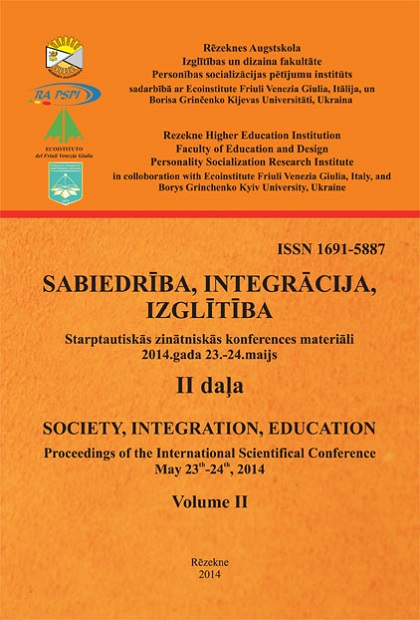ECONOMIC ASPECTS OF LIFELONG LEARNING IN LATVIAN REGIONS
DOI:
https://doi.org/10.17770/sie2014vol2.676Keywords:
lifelong learning, Latvian regions, knowledge market, lifelong learning services and prices, economic development stagesAbstract
despite the extreme urgency of lifelong learning in the era of knowledge economy, employers in Latvia’s regions are not active investors in the training of their employees, and individuals are not eager to actively educate themselves throughout their lives, mentioning the expensiveness of lifelong learning – unlike in the majority of EU Member States – as the key reason. Therefore, one can identify the discrepancy between the political priorities and the actual situation. The author, following the idea of Latvia’s scientist A.Jaunzems to perceive knowledge purely economically – as a product of the education market – developed this idea further by examining the knowledge market in Latvia’s regions in regard to its institutional “casing”, i.e. lifelong learning. The research findings show that the regional specifics of lifelong learning in Latvia are determined by the fact that Latvia’s regions are in different stages of economic development.Downloads
References
Arrow, K.J., Debreu, G. (1954). The existence of an equilibrium for a competitive economy. Econometrica, 22(3), 265–290.
Delors, J. (1996). Learning: the treasure within. Report to UNESCO of the International Commission on Education for the 21st Century. Paris: UNESCO.
Dorothy, L. (1998). Wellsprings of Knowledge. Boston: Harvard Business School Press.
Eglītis, J. (2003). Izglītības kvalitātes nodrošināšanas reģionālie un ekonomiskie aspekti. Promocijas darbs. Jelgava: LLU.
Eglītis, J., Jermolajeva, E. (2007). Vispārējās izglītības finansējums Latvijā - problēmas un perspektīvas. Izglītība zināšanu sabiedrības attīstībai Latvijā, 13(2), 224-236.
European Comission. (2013). Lifelong learning statistics. Available: http://epp.eurostat.ec.europa.eu/statistics_explained/index.php/Lifelong_learning_statistics (accessed 24.02.2014).
Eurostat. (2007). Obstacles to participation in education and training, 2007. Lifelong learning statistics. Available: http://epp.eurostat.ec.europa.eu/statistics_explained/index.php/Lifelong_learning_statistics (accessed 24.02.2014).
Jaunzems, A. (2011). Ekonomikas un vadzinību izglītības Latvijas tirgus mikroekonomiskais modelis. Mevdeckis A. (Sast.) Sabiedrība un kultūra. Rakstu krājums, XIII, 621−642.
Jaunzems, A. (2013). Štakelberga-Neša alternatīvas Latvijas izglītības tirgū. LZA Vēstis, A, 67(1/2), 23-43.
Kokosalakis, N. (2000). Lifelong learning in European universities: a preliminary assessment. European Journal of Education, 35(3), 253-375.
Kokosalakis, N., Kogan, M. (2001). Lifelong learning: the implications for universities in the EU. Final Report. Available: http://improving-ser.sti.jrc.it (accessed 24.02.2014).
Mandler, M. (1999). Dilemmas in economic theory: persisting foundational problems of microeconomics. Oxford: Oxford University Press.
McKenzie, L.W. (1959). On the existence of general equilibrium for a competitive economy. Econometrica, 27(1), 54–71.
McKenzie, P. (2001). How to make lifelong learning a reality: implications for the planning of educational provision in Australia. Aspin, D., Chapman, J., Hatton, M., Dordrecht, Y. S. (Eds.) International handbook on lifelong learning. Boston: Kluwer Academic Publishers.
Millere, I., Medne, L., Rozenbergs, V. (2007). Ieguldījumu nepieciešamības izvērtējums viesmīlības nozares cilvēkkapitālā. Eiropas Sociālā fonda finansētās aktivitātes ,,Atbalsts darba tirgus pētījumu veikšanai” Gala ziņojums. Jelgava: LLU.
Mitra-Kahn, B. H. (2008). Debunking the myths of computable general equilibrium models."Schwarz Center for Economic Policy Analysis Working Paper No. 01-2008.
Paņina, L. (2011). Latvijas augstākās izglītības sistēmas efektivitātes izpēte un vidēja termiņa attīstības modeļi. Promocijas darbs. Daugavpils: DU.
Pring, R.A. (1995). Closing the gap: liberal education and vocational preparation. Hodder&Stoutgghton.
Rutkovskis, E. (2013). Cilvēkresursu kā darbaspēka pieejamības analīze Austrumlatgales darba tirgū sociāli-ekonomiskajā aspektā. Available: http://www.kra.lv/wp-content/uploads/2013/07/E.Rutkovskis1.pdf (accessed 24.02.2014).
Sannikova, A., Baltere, R. (2008). Mūžizglītība un nodarbinātība Latvijā. Latvijas Ekonomists. 8, 26-32.
Saulītis, J., Briede, L. (2006). Izglītības sistēmas komercializācija un globalizācija. Tautsaimniecības un uzņēmējdarbības attīstības problēmas. Starptautiskas konferences zinātniskie raksti. Rīga: RTU, 198–203.
Schwab, K. (Ed.) (2013). The Global Competitiveness Report 2013-2014. Geneva: World Economic Forum.
Stewart, T.A. (1996). Intellectual Capital: The New Wealth of Organizations. McGraw-Hill.
LR Cabinet of Ministers. (2005). Ilgtermiņa konceptuālais dokuments „Latvijas izaugsmes modelis: Cilvēks pirmajā vietā”. Rules No. 684, 19.10.
LR Cabinet of Ministers. (2006). Nacionālais attīstības plāns 2007.- 2013. Available: http://www.politika.lv/index.php?id=10035 (accessed 24.02.2014).
LR CSB. (2013a). Table PIA64_L: Average costs spent by participant on adult education by sex, age, level of education and labour status (in lats). Statistical database. Available: http://www.csb.gov.lv/dati/statistikas-datubazes-28270.html (accessed 24.02.2014).
LR CSB. (2013b). Table PCG02. Consumer price changes by commodity groups. Statistical database. Available: http://www.csb.gov.lv/dati/statistikas-datubazes-28270.html (accessed 24.02.2014).
LR CSB. (2013c). Table DSG11_L: Average monthly gross wages and salaries in statistical regions of Latvia by kind of activity (in lats). Statistical database. Available: http://www.csb.gov.lv/dati/statistikas-datubazes-28270.html (accessed 24.02.2014).
LR CSB. (2013d). Table DSG10_L: Average monthly wages and salaries by statistical region of Latvia (in lats). Statistical database. Available: http://www.csb.gov.lv/dati/statistikas-datubazes-28270.html (accessed 24.02.2014).
LR CSB. (2013e). Table DSG14_L: Average gross wages and salaries per month by major occupational groups and form of ownership in statistical regions (in October, in lats), 2004-2005. Statistical database. Available: http://www.csb.gov.lv/dati/statistikas-datubazes-28270.html (accessed 24.02.2014).
Velupillai, K. V. (2006) Algorithmic foundations of computable general equilibrium theory. Applied Mathematics and Computation, 179(1), 360–369.


